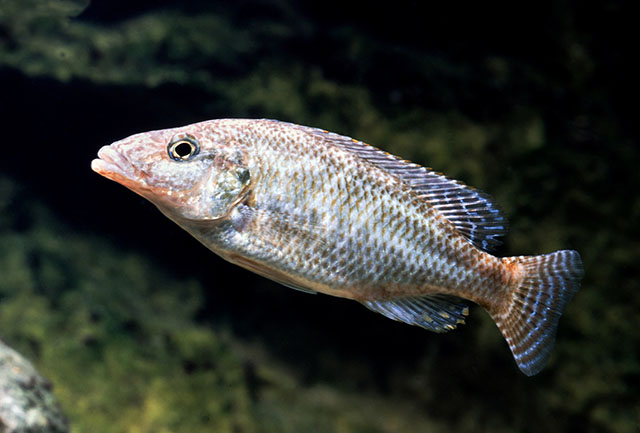| Cichlidae (Cichlids), subfamily: Pseudocrenilabrinae |
| 25 cm TL (male/unsexed) |
|
demersal; freshwater; pH range: 7 - 8.5; dH range: 10 - 15; depth range 2 - 61 m |
| Africa: Endemic and of widespread occurrence in Lake Malawi. |
|
Dorsal spines (total): 16-17; Dorsal soft rays (total): 10-11; Anal spines: 3-3; Anal soft rays: 9-9. Diagnosis: shallow head with downward-directed snout and subterminal mouth; long premaxillary pedicel, >36% head length; spots on pectoral fins, and speckles on head and body present (Ref. 55922).
Description: proboscis-like snout; ventral outline of head flat; outer teeth in jaw stout and bicuspid, in the largest specimens a mixture of mainly weakly bi- and unicuspid teeth; inner teeth in jaw stout, tricuspid and slightly recurved; 3 series of scales on cheek; lower pharyngeal jaw broad and shallow; pharyngeal teeth widely set, sharp and stout, but not enlarged; gill-rakers normal-sized or somewhat short, the largest ones slightly flattened but not polyfid; 24-26 scales in upper part of lateral line, 15-16 in lower part; 5-6 scales between pectoral and pelvic fins (Ref. 55922).
Coloration: Live: melanin pattern as in preserved specimens; nuptial color pattern overlays the speckled pattern in both males and females (Ref. 55922). Adult territorial males: spotted pattern not readily observable; dorsal, caudal and anal fins blue; dorsal fin with orange lappets and white submarginal band; maculae and striae not well developed; anal fin yellow/orange distally; pectoral fins transparent with blue-grey hue; pelvic fins grey with white leading edge (Ref. 55922). Females: background color white or yellow with many dark brown speckles and spots, to a large extend arranged in rows on dorsal, caudal and anal fins (Ref. 55922). Color pattern of immature and non-territorial males intermediate between female pattern and adult male pattern, with an increasing intensity of blue on the body with increasing territoriality (Ref. 55922). Preserved: speckled pattern on head, body and fins, sometimes difficult to see and then only observable as a pattern of dark and light color on each individual scale; basic body color yellow to brown; typical Nimbochromis-pattern of blotches vague and difficult to see; dorsal fin lappets, trailing edge of pelvic fins and ventral margin of anal fin whitish; maculae in caudal fin arranged in vertical rows in small specimens (<113.5mm)(Ref. 55922). |
| Inhabits the rocky (Ref. 5595, 55922) and intermediate habitats (Ref. 55922). Piscivorous; observed ambushing fish prey (Ref. 5595, 55922). |
|
Least Concern (LC); Date assessed: 20 June 2018 Ref. (130435)
|
| harmless |
|
Source and more info: www.fishbase.org. For personal, classroom, and other internal use only. Not for publication.

